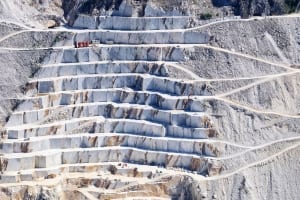Valuable Natural Materials: Three Things to Keep in Mind About Limestone Extraction

What is Limestone?
Limestone is a natural stone consisting of carbonate sediments containing skeletal fragments of long-dead sea creatures such as coral, mollusks, and foraminifera. The minerals in limestone are aragonite and calcite. This stone is formed over millions of years of sedimentation. During the formation process, it is soluble to water and weak acid solutions. Because of this, cave systems and karst landscapes are formed.
Limestone contains impurities such as sand, clay, iron oxide, organic remains, and other materials that give it its pattern and color. For this reason, limestone will have unique colors and patterns at each extraction site. Limestone is a popular building material because it is fairly common and easy to work with. Limestone can be cut into building blocks or thin plates used as a building facade.
Quarrying Limestone
Limestone is a natural product of the earth and must be extracted by different methods. Limestone Quarry methods determine the quality and beauty of the limestone. Quarries or open mines are used to extract limestone and many other types of rocks used in the building and other industries. Methods of extracting rocks in the quarrying process include digging, heating, wedging, and blasting. The blasting process includes drilling holes with machines and filling them with explosive powders and tamping materials such as ash, clay, fuses and wiring. Then, an electric power supply is used to fire the fuses and explosives. The explosions help to remove sections of limestone from their natural bed.
There are different methods of running quarries and of safely extracting limestone. The best manufacturers use quarrying methods that result in the best slabs of limestone with the least damage to the area surrounding the quarry. When all the limestone has been extracted from a site a large hole is left which can fill with water forming a lake.
Before a quarry is started there will be an analysis of the resource to determine if there is enough good-quality limestone to make the quarry economically viable. This often involves a geological study. The quarry must be licensed and meet local environmental requirements.
Three Considerations For Limestone Extraction.
Three considerations for choosing and using limestone include:
- Is limestone suited to the building project? There are other natural stone products to consider. Some are harder than limestone and some have different textures and colorations. Consider the pros and cons of each material. For instance, limestone is susceptible to acids so using it on the exterior of a building where there is acid rain might present maintenance problems over time.
- How was this limestone quarried? Some limestone extraction companies use quarrying methods that are bad for the environment. Architects and builders should use suppliers of limestone building materials that use environmentally friendly methods of extraction and manufacture.
- Is the chosen stone within the budget and is there sufficient quantities of matching material? This is a natural material and if the job runs short, it is not possible to make more to match.
When the right limestone material is chosen for a building project, the results can be very durable and attractive. Limestone is fairly common and therefore budget-friendly. It is a durable attractive choice for building projects.













Leave a Reply
Want to join the discussion?Feel free to contribute!